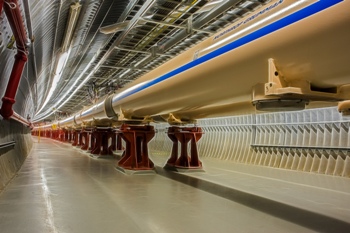Apr 20 2013
A stark black-and-white photo of an access tunnel 1,500 meters underground at the Italian Institute for Nuclear Physics' Gran Sasso National Laboratory and a colorful close-up of a detector at INFN's Frascati National Laboratory that wouldn't be out of place in a building by Antoni Gaudi have won the top prizes in the second Global Particle Physics Photowalk.
 Brookhaven Lab's Relativistic Heavy Ion Collider (RHIC) is really two accelerators in one—these crisscrossing particle racetracks consist of 2.4 miles of superconducting magnets. Inside these high-tech tunnels, beams of heavy ions and polarized protons accelerate in opposite directions at nearly the speed of light before inside detectors. Photographer: Steve Zimic
Brookhaven Lab's Relativistic Heavy Ion Collider (RHIC) is really two accelerators in one—these crisscrossing particle racetracks consist of 2.4 miles of superconducting magnets. Inside these high-tech tunnels, beams of heavy ions and polarized protons accelerate in opposite directions at nearly the speed of light before inside detectors. Photographer: Steve Zimic
In September 2012, hundreds of amateur and professional photographers had the rare opportunity to explore and photograph accelerators and detectors at particle physics laboratories around the world.
The top thirty-nine photographs from the Photowalk, including the six winners of the jury and "people's choice" competitions, are now viewable online.
"The worldwide opening of the physics laboratories for the Photowalk has been an excellent opportunity for showing the real places of physics research," said Antonio Zoccoli, a member of the INFN Executive Board. "The Photowalk tells us that scientific research is a global enterprise, which brings together intelligence, resources and technologies from different countries toward a common goal. Of course we are delighted that in the 2013 edition of Photowalk both the jury and popular vote were awarded to photos of INFN locations."
In the InterActions Physics Photowalk, ten of the world's leading particle physics laboratories offered special behind-the-scenes access to their scientific facilities:
- Brookhaven National Laboratory (New York, USA)
- Catania National Laboratory (Catania, Italy)
- Chilbolton Observatory (Hampshire, UK)
- Daresbury Laboratory (Cheshire, UK)
- Fermi National Accelerator Laboratory (Illinois, USA)
- Frascati National Laboratory (Frascati, Italy)
- Gran Sasso National Laboratory (Gran Sasso, Italy)
- Rutherford Appleton Laboratory (Oxfordshire, UK)
- TRIUMF (Vancouver, Canada)
- United Kingdom Astronomy Technology Centre (Edinburgh, UK)
Participating photographers submitted thousands of photos for local competitions. Each laboratory selected local winners, and advanced these top photographs to two global competitions.
More than 1,250 photography enthusiasts voted online to name the global people's choice winners. Nino Bruno's photograph of a tunnel connecting the underground halls of INFN's Gran Sasso National Laboratory garnered the most votes, followed closely by Enrique Diaz's side view of the STAR detector at Brookhaven National Laboratory, and Steve Zimic's photograph of the tunnel that houses Brookhaven's RHIC accelerator.
Bruno, a building contractor in L'Aquila, said that he is just starting out in the world of photography and participating in the Photowalk was "an extremely exciting and stimulating experience."
A panel of international judges also selected three winners. The judges—photographers Stanley Greenberg from the United States, Roy Robertson from the United Kingdom, Andrew Haw from Canada and Luca Casonato from Italy—awarded the top prize to Joseph Paul Boccio's detailed photograph of the KLOE detector at INFN's Frascati National Laboratory, second prize to Andy White's photo capturing the color and symmetry of the TIGRESS detector at the Canadian laboratory TRIUMF, and third prize to Helen Trist's photograph of data storage at the UK's Rutherford Appleton Laboratory.
Boccio, a student of Natural Science in Rome, said that "the Photowalk was really extraordinary and gave me the possibility to experience, in a single moment, the two main passions of my life: science and photography."
Trist, the third-place winner, said that "taking part in the Photowalk at Rutherford Appleton Laboratory was a great opportunity to see behind the scenes at a cutting-edge science laboratory. From a photographer's perspective I found so many inspiring shapes, colors, textures and lead-in lines to photograph and I enjoyed the challenge of trying to think on the spot how to capture the photograph in different ways so as to 'make it mine.'"
The winning photographs will be featured in upcoming issues of the particle physics publications the CERN Courier and symmetry and the Italian popular science magazine Le Scienze. The participating laboratories will also feature the global winners and their local Photowalk selections in temporary exhibits.
"The progress of physics is naturally driven by curious and creative minds who strive to understand the world around us," said Tim Meyer, Head of Strategic Planning and Communications at TRIUMF. "By inviting photographers into our laboratory, we have the opportunity, for a moment, to see our world as they see—recorded in their images. We see what catches their equally curious and creative eye, and we get to better appreciate the work in which we are all engaged."
The Particle Physics Photowalk was organized by the InterAction Collaboration, whose members represent particle physics laboratories in Asia, North America and Europe.
Visit http://www.interactions.org/photowalk for more information about the Global Particle Physics Photowalk.